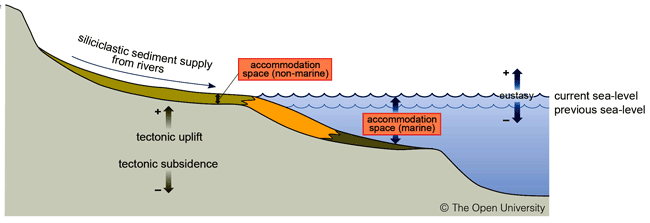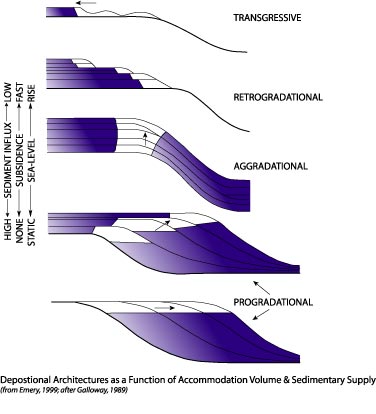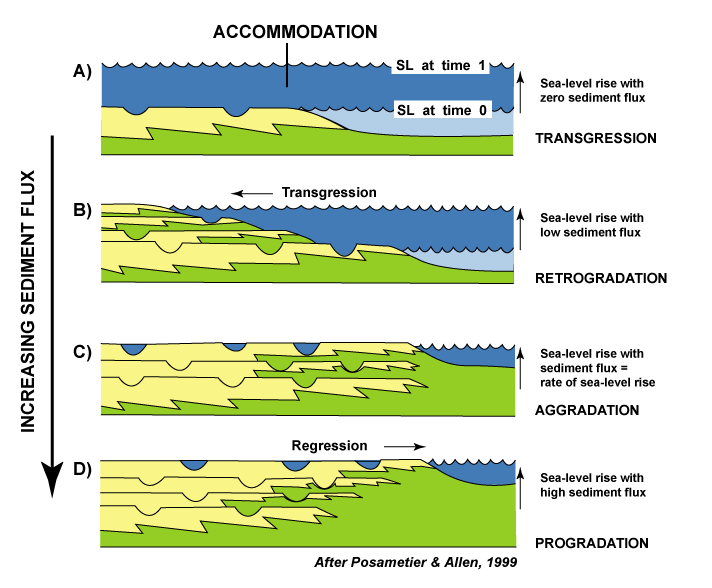|
aggradation
base level
clinoform surface
ecological accommodation
eustasy
fondoform surface
parasequence
progradation
relative sea level
relative sea level fall
relative sea level rise
regression
retrogradation
trajectory of shoreline
transgression
undaform surface
wave base

|
accommodation is defined by Jervey (1998) as "the space available for potential sediment accumulation". This space is the combined product of movement of:
- The sea surface (eustasy: global sea level measured from a datum such as the center of earth)
- The sea floor (tectonics)
- Changes in rates of sediment accumulation.

Jervey (1998) suggested that the major controls on accommodation are changes in relative sea level (i.e. the combined product of eustasy and tectonic movement). Curray, (1964), Posamentier & Allen, (1999), Coe et al (2002), and Catuneanu (2002), among many others, put an emphasis on rates of sedimentation as at least a co-equal control of accommodation. As demonstrated below changes of relative sea level balanced against rates of sediment accumulation lead to accommodation space that is responsible to transgressions and regressions.
: 

Helland-Hansen & Martinsen (1960) consider the processes responsible for the slope of the trajectory taken by these retrogradational, aggradational and progradational parasequences of a shoreline. They suggest that this is controlled by the character of the accommodation and its interaction with the flux of sediment into these marine settings. This flux is reflected in transportion via the shoreline (the maximum wave energy zone) and redistribution in response to the hydrodynamic regime of the basin. Pomar & Kendall (in review) describe how sediments aggrade till waves and currents move them down-shelf, flattening of the depositional profile. These profiles are not only associated with the original accommodation as it relates to the slope but a basinward grain-size decrease that reflects the balance between input, redistribution and accumulation of sediment (Johnson, 1919; Reineck and Singh, 1980; Allen, 1982; Swift et al. 1991b). The resulting "physical" accommodation is modified by this "shelf equilibrium profile" of Swift and Thorne (1991). This profile of Swift and Thorne (1991) represents a conceptual surface of dynamic equilibrium similar to the "marine profile of equilibrium" of Dietz (1963). It is an expression of the notion of wave-base matching the greatest depth to which the bottom is stirred by waves during storms (Rich, 1951).
Thus "physical" accommodation comprises the space between sea floor and the "shelf equilibrium profile" of Swift and Thorne (1991), and the undaformform, clinoformform and fondoforms of Rich (1951). In fact the "base level" for sediment accumulation tends to match the "shelf equilibrium profile" and is often confused with sea level. This should be no surprise since base-level datum will be effectively equivalent to sea level when associated with overfed sedimentary systems like deltas. Conversely the "dynamic equilibrium" between sediment input and hydrodynamic power mean that deepening of the shelf equilibrium profile (delta retreat) will result if there is a subsequent decrease in sediment supply.
In conclusion eustasy and total sea-floor subsidence, as well as changes in hydrodynamic conditions, govern many of the changes of accommodation space. It should be recognized that unlike the accommodation of siliciclastics described above, the accommodation space for carbonates, is affected by hydrodynamics, but also the capacity of organisms to produce and to accumulate sediments above certain hydrodynamic thresholds. This later effect is the ecological accommodation defined by Pomar (2001 a and b).

References
Allen, JRL, 1982, A model of storm sedimentation in shallow waters sedimentary structures: their character and physical basis: Developments in Sedimentology, 30B. Elsevier, Amsterdam p. 487-506.
Catuneanu,O., 2002, sequence stratigraphy of clastic systems: concepts, merits, and pitfalls, Journal of African Earth Sciences, Volume 35, Issue 1, Pages 1-43
Coe, Angela, Dan Bosence, Kevin Church, Steve Flint, John Howell and Chris Wilson, (2002), The Sedimentary Record of Sea Level Change , Cambridge University Press, 288 pp.
Curray, J.R., 1964, transgressions and regressions, in Miller, RL, ed., Papers in Marine Geology: New York, The Macmillan Company, p. 175-203.
Dietz, R.S., 1963, Wave-base, marine profile of equilibrium, and wave-built terraces: A critical appraisal, Geological Society of America Bulletin, v. 74, p. 971-990.
Helland-Hansen, W., and Martinsen, O.J., 1996, shoreline trajectories and sequences: description of variable depositional-dip scenarios, Journal of Sedimentary Research 66 (4), 670–688.
Jervey, M.T., 1988, Quantitative geological modeling of siliciclastic rock sequences and their seismic expression, in Wilgus, C.K., Hasting, B.S., Kendall, C.G.St.C, Posamentier, HW, Ross, CA, and Van Wagoner, JC, eds., Sea-level changes: an integrated approach: Tulsa, OK, Society of Economic
Paleontologists and Mineralogists, Special Publication No. 42, p. 47-69.
Johnson, D.W., 1919, Shore processes and shoreline development, (1st edition): New York, Wiley, 584 p.
Reineck, H.E., and Singh, I.B., 1980, Depositional Sedimentary Environments, Springer-Verlag, Berlin, Heidelberg, New York, 549 pp.
Posamentier, H.W., Allen, G.P., 1999, Siliciclastic sequence stratigraphy: concepts and applications, SEPM Concepts in Sedimentology and Paleontology no. 7, 210 p
Rich, J.L., 1951, Three critical environments of deposition and criteria for recognition of rocks deposited in each of them, Geological Society of America Bulletin, v. 62, p. 1-20.
Swift, D.J.P., and Thorne, J.A., 1991, Sedimentation on continental margins, I: a general model for shelf sedimentation, in Swift, D.J.P., Oertel, G..F, Tillman, R.W., and Thorne, J.A., eds., Shelf sand and sandstone bodies, International Association of Sedimentologists Special Publication, No. 14, p. 3-31.
Swift, D.J.P., Phillips, S., and Thorne, J.A., 1991, Sedimentation on continental margins, VI: lithofacies and depositional systems, in Swift, D.J.P., Oertel, G.F., Tillman, R.W., and Thorne, J.A., eds., Shelf sand and sandstone bodies, IAS Special Publication, v. 14, p. 89-152. |